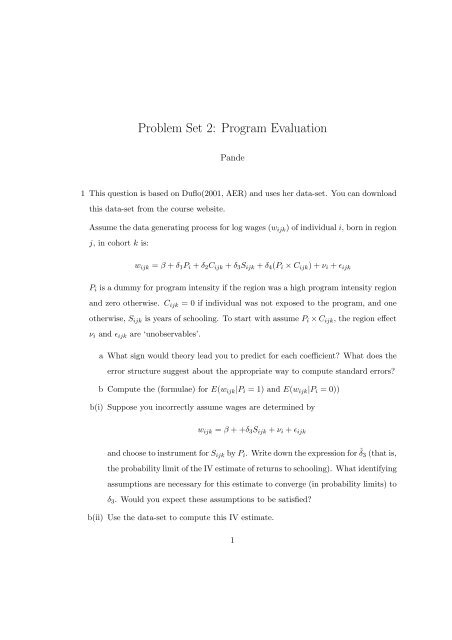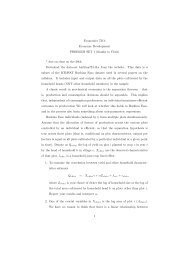Problem Set 2: Program Evaluation
Problem Set 2: Program Evaluation
Problem Set 2: Program Evaluation
Create successful ePaper yourself
Turn your PDF publications into a flip-book with our unique Google optimized e-Paper software.
<strong>Problem</strong> <strong>Set</strong> 2: <strong>Program</strong> <strong>Evaluation</strong>Pande1 This question is based on Duflo(2001, AER) and uses her data-set. You can downloadthis data-set from the course website.Assume the data generating process for log wages (w ijk ) of individual i, born in regionj, in cohort k is:w ijk = β + δ 1 P i + δ 2 C ijk + δ 3 S ijk + δ 4 (P i × C ijk ) + ν i + ɛ ijkP i is a dummy for program intensity if the region was a high program intensity regionand zero otherwise. C ijk = 0 if individual was not exposed to the program, and oneotherwise, S ijk is years of schooling. To start with assume P i × C ijk , the region effectν i and ɛ ijk are ‘unobservables’.a What sign would theory lead you to predict for each coefficient? What does theerror structure suggest about the appropriate way to compute standard errors?b Compute the (formulae) for E(w ijk |P i = 1) and E(w ijk |P i = 0))b(i) Suppose you incorrectly assume wages are determined byw ijk = β + +δ 3 S ijk + ν i + ɛ ijkand choose to instrument for S ijk by P i . Write down the expression for ˆδ 3 (that is,the probability limit of the IV estimate of returns to schooling). What identifyingassumptions are necessary for this estimate to converge (in probability limits) toδ 3 . Would you expect these assumptions to be satisfied?b(ii) Use the data-set to compute this IV estimate.1
c(i) Write down the expressions for average wages for individuals exposed to theprogram and those not exposed to program in high and low program intensityregions (four conditional expectations, i.e. [E(w ijk |P i = 1, C ijk = 1)..]c(ii) Use your answer to c(i) to write down the difference-in-difference estimator usedby Duflo, and discuss the conditions which must be satisfied for consistency.c(iii) The fixed effect regression constitutes a generalization of a difference in differenceestimator when there are more than two groups and more than two time-periods.Write down the fixed effect regression which is the counterpart to the differencein difference estimator discussed above, and estimate this regression using thedata-set.2 Regression discontinuity (based on Jacobs 2002):a In 1996, the Chicago Public Schools instituted an accountability policy that tied summerschool and promotional decisions to performance on standardized tests. Thirdgraders must obtain a minimum score of 2.8 grade equivalents in both reading andmath achievement on the Iowa Test of Basic Skills (ITBS) in order to advance. Someonewho received 2.8 on reading but 2.7 on math had to go to remedial summerschool.. Assume data on the cohort of students who were in the third and sixth grade fromthe 1993-1994 school year to the 1998-1999 school years is available.(i) We are interested in estimating the treatment effect of remedial summer school:Y it+1 = X it + β 1 T reat it + u i + ɛ it+1where Y is the outcome, X is a vector of demographic and past performance variables,and Treat is a binary variable that takes on a value of one if a student went to summerschool and zero otherwise, u represents unobserved (to the researcher) student ability,ɛ is an error term, and t and i are time and individual subscripts respectively.(a) Discuss the potential biases with using OLS2
(b) Discuss how you can use the nature of the Chicago accountability policy to designa regression discontinuity evaluation of the above(c) State the assumptions underwhich the regression discontinuity policy is valid3




